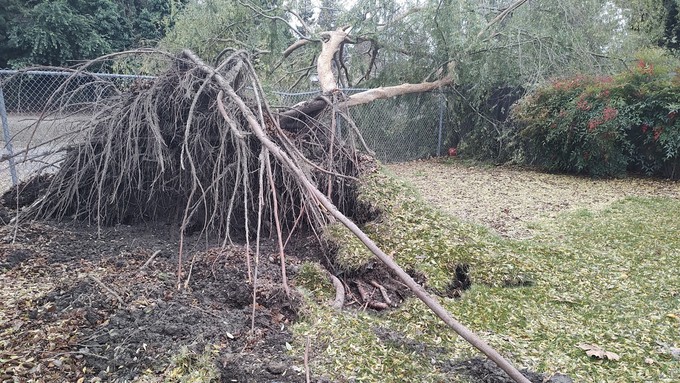
Watch out for leaning trunks and sagging branches

This 25-foot elm in the Pocket neighborhood of Sacramento came down during the New Year's Eve storm. Note the fissures in the lawn. Debbie Arrington
With the downpour on New Year’s Eve, 2022 made up for what had been a very dry year. And 2023 is starting soggy, too.
Record rain had a huge impact on the greater Sacramento area with flooding in south Sacramento County, major power outages and fallen trees all over the place.
According to the National Weather Service, downtown Sacramento received 2.37 inches on New Year’s Eve – a record for that date – and 4.81 inches fell since Christmas. That brought December’s total to 9.5 inches – almost triple the normal (3.49 inches) for that month.
December brought our seasonal total to 10.66 inches since Oct. 1, the start of our “water year.” That total is 148% of normal for that period, which is good news for our reservoirs and drought perspective.
More rain is on the way, says the weather service. Today (Monday) will see a quick-moving storm with less than one-third inch predicted for downtown Sacramento. The real threat comes Wednesday and Thursday; over 48 hours, an estimated 2.5 to 3 inches of rain is expected to fall.
All this moisture puts trees at risk. Be on the lookout for sagging branches and leaning trees.
Water accumulates in the needles of evergreens, stressing limbs with the extra weight. Horizontal limbs are at the greatest risk of breaking. The tree may groan or creak, often a signal that a branch is about to fall – or the whole tree is coming down.
Lawn trees – particularly those affected by drought – are especially susceptible to uprooting; all it takes are strong winds to accompany that moisture. Need proof? On New Year’s Eve, dozens of trees fell in Sacramento neighborhoods, pushed over by 40 mph gusts.
Lawn trees tend to have shallow roots and less of a foothold. If the soil is soggy, those roots give way.
Before the tree falls, there are usually warning signs, such as fissures in the soil around the tree. That’s a sign the roots are pulling loose.
If you see such fissures, stay away from the tree and call a certified arborist immediately. Your tree may be saved with quick action (and support). Never walk under a leaning tree; the soil may be too unstable.
For more information on tree care and finding an arborist, go to: www.sactree.org.
Comments
0 comments have been posted.Sacramento Digs Gardening to your inbox.
Food in My Back Yard Series
May 6: Maintain soil moisture with mulch for garden success
April 29: What's (already) wrong with my tomato plants?
April 22: Should you stock up on fertilizer? (Yes!)
April 15: Grow culinary herbs in containers
April 8: When to plant summer vegetables
April 1: Don't be fooled by these garden myths
March 25: Fertilizer tips: How to 'feed' your vegetables for healthy growth
March 18: Time to give vegetable seedlings some more space
March 11: Ways to win the fight against weeds
March 4: Potatoes from the garden
Feb. 25: Plant a fruit tree now -- for later
Feb. 18: How to squeeze more food into less space
Feb. 11: When to plant? Consider staggering your transplants
Feb. 4: Starting in seed starting
Sites We Like
Garden Checklist for week of May 4
Enjoy this spring weather – and get gardening!
* Plant, plant, plant! It’s prime planting season in the Sacramento area. Time to set out those tomato transplants along with peppers and eggplants. Pinch off any flowers on new transplants to make them concentrate on establishing roots instead of setting premature fruit.
* Direct-seed melons, cucumbers, summer squash, corn, radishes, pumpkins and annual herbs such as basil.
* Harvest cabbage, lettuce, peas and green onions.
* In the flower garden, direct-seed sunflowers, cosmos, salvia, zinnias, marigolds, celosia and asters. (You also can transplant seedlings for many of the same flowers.)
* Plant dahlia tubers. Other perennials to set out include verbena, coreopsis, coneflower and astilbe.
* Transplant petunias, marigolds and perennial flowers such as astilbe, columbine, coneflowers, coreopsis, dahlias, rudbeckia and verbena.
* Keep an eye out for slugs, snails, earwigs and aphids that want to dine on tender new growth.
* Feed summer bloomers with a balanced fertilizer.
* For continued bloom, cut off spent flowers on roses as well as other flowering plants.
* Add mulch to the garden to maintain moisture. Mulch also cuts down on weeds. But don’t let it mound around the stems or trunks of trees or shrubs. Leave about a 6-inch to 1-foot circle to avoid crown rot or other problems.